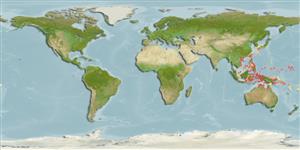>
Gobiiformes (Gobies) >
Gobiidae (Gobies) > Gobiinae
Etymology: Ancistrogobius: Name from Greek word 'agkistros' meaning fishhook and Gobius , a genus name of gobiine fish, in reference to the short, ventrally directed, spur-like preopercular spine.; yanoi: Named for K.Yano, who provided several type specimens and habitat information for all the new species of Ancistrogobius..
Environment: milieu / climate zone / depth range / distribution range
Sinh thái học
Biển Sống nổi và đáy; Mức độ sâu 0 - 12 m (Ref. 84001). Tropical
Western Pacific: Japan to Indonesia, to the Solomons. Two specimens from the Red Sea provisionally identified as this species.
Bộ gần gũi / Khối lượng (Trọng lượng) / Age
Maturity: Lm ? range ? - ? cm
Max length : 3.7 cm SL con đực/không giới tính; (Ref. 84001); 3.6 cm SL (female)
Short description
Hình thái học | Sinh trắc học
Các tia vây lưng cứng (tổng cộng): 7; Các vây lưng mềm (tổng cộng): 10; Tia cứng vây hậu môn 1; Tia mềm vây hậu môn: 9. This species differs from its congeners in having the following set of characters: no scales on head and most of nape (no predorsal scales); third spine of first dorsal fin elongate and filamentous, obviously longer than preceding spine (at least in specimens that are more than 21 mm SL), with alternating pale and dusky pattern in life or when fresh (typically faded and indistinct in preserved specimens, but its distal tip tinged with black); 17-19 (usually 18 or 19) pectoral-fin rays 1; pelvic fins fused medially by well developed connecting membrane and frenum (frenum often rudimentary); fifth segmented ray of pelvic fin 89.9-100.0% of preceding ray in length; faint, dusky blotches below eye (not forming a distinct vertical bar); distal tip of first dorsal fin with a black blotch, relatively wide, extending posteriorly to just behind third spine (but not to middle of third interspinal membrane); sensory papilla rows x^1 and x^2 not continuous (interrupted by row trp); sensory papilla rows trp extending dorsally to slightly above a longitudinal line through rows x^1 + x^2; anterior tip of sensory papilla row b closed to, or attaching with, row 4 and well apart from row 3; row d typically extending posteriorly to well beyond ventral end of row 6i (Ref. 84001).
Collected from sandy-mud bottoms at depths of 0-12 m (Ref. 84001).
Life cycle and mating behavior
Chín muồi sinh dục | Sự tái sinh sản | Đẻ trứng | Các trứng | Sự sinh sản | Ấu trùng
Shibukawa, K., T. Yoshino and G.R. Allen, 2010. Ancistrogobius, a new cheek-spine goby genus from the West Pacific and Red Sea, with descriptions of four new species (Perciformes: Gobiidae: Gobiinae). Bull. Natl. Mus. Nat. Sci., Ser. A, (Suppl. 4):67-87. (Ref. 84001)
IUCN Red List Status (Ref. 130435)
Threat to humans
Harmless
Human uses
Thêm thông tin
Age/SizeSự sinh trưởngLength-weightLength-lengthLength-frequenciesSinh trắc họcHình thái họcẤu trùngSự biến động ấu trùngBổ xungSự phong phúBRUVS
Các tài liệu tham khảoNuôi trồng thủy sảnTổng quan nuôi trồng thủy sảnCác giốngDi truyềnElectrophoresesDi sảnCác bệnhChế biếnNutrientsMass conversion
Các công cụ
Special reports
Download XML
Các nguồn internet
Estimates based on models
Preferred temperature (Ref.
123201): 26.7 - 29.4, mean 28.8 °C (based on 1104 cells).
Phylogenetic diversity index (Ref.
82804): PD
50 = 0.5625 [Uniqueness, from 0.5 = low to 2.0 = high].
Bayesian length-weight: a=0.00708 (0.00333 - 0.01504), b=3.09 (2.92 - 3.26), in cm total length, based on LWR estimates for this (Sub)family-body shape (Ref.
93245).
Mức dinh dưỡng (Ref.
69278): 3.2 ±0.3 se; based on size and trophs of closest relatives
Fishing Vulnerability (Ref.
59153): Low vulnerability (10 of 100).
